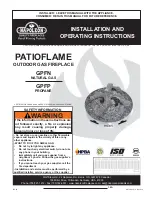
20
Dutchwest Seneca
2006063
WARNING: For safety and greatest efficiency,
operate your stove only with all doors fully closed.
The test standard when the stove is operated in this
mode is UL1482.
Your stove may be operated as a fireplace with the
doors opened or removed only when the spark
screen is placed correctly in the opening to protect
against the possibility of sparks and embers leav-
ing your stove. The test standard for your stove
when it is operated in this mode is UL737.
Use only the Seneca spark screen, Part Number
0134, with your Seneca.
Seneca spark screens are available from your
Dutchwest authorized dealer.
1. Open the stove damper, and open the primary air
control fully. Open the combustor air control two
turns.
2. Place several sheets of crumpled newspaper in the
stove. Do NOT use glossy advertisements or colored
paper, as they can poison the catalyst. Place on the
paper six or eight pieces of dry kindling, split to a
finger-width size, and on the kindling lay two or three
larger sticks of split dry wood that are approximately
1-2” (25-50mm) in diameter.
Fig. 25 The best wood is air-dried outside under cover for at
least a year.
ST263
DO NOT USE CHEMICALS OR FLUIDS TO START
THE FIRE. DO NOT BURN GARBAGE OR FLAM-
MABLE FLUIDS SUCH AS GASOLINE, NAPTHA OR
ENGINE OIL. Also, never use gasoline-type lantern
fuel, kerosene, charcoal lighter fluid, or similar liquids to
start or “freshen up” a fire in this heater. Keep all such
liquids well away from the heater while it is in use.
3. Light the newspaper and close the door. Gradually
build up the fire by adding a few 3-5” (80-120mm)
diameter splits. If this is one of the first few “break-
in” fires, let the fire burn brightly, and then let it die
out.
ST264
Fig. 26 Add larger pieces of wood as the fire begins to burn
well.
If the break-in procedure has been completed, wait
10-15 minutes until the fire is will-established;
gradually build it up by adding a few sticks at a time
of a progressively larger size. Continue until you
have a live ember bed about 2” (50mm) thick.
ST264a
Fig. 27 Add full-size logs after the ember bed is 3” (75mm)
deep.
You will soon find out that this stove is HOT WHILE IN
OPERATION! KEEP CHILDREN, CLOTHING AND
FURNITURE AWAY. CONTACT MAY CAUSE SKIN
BURNS.
NOTE: Some chimneys need to “primed”, or warmed
up, before they will draw sufficiently to start a fire. To
correct this situation, roll up a couple pieces of newspa-
per, place them on top of the kindling and toward the
back of the stove, light them and close the doors. This
should heat the chimney enough to initiate a draft.
Once the draft is established, open the front door and
light the rest of the fuel from the bottom. Do not light the
main bed of fuel until the chimney begins drawing, and
repeat the procedure as often as necessary if the initial
attempt is unsuccessful.
4. After the temperature on the probe thermometer has
reached 500-800
°
F (260-430
°
C) (depending on your
individual wood and draft situation), close the stove
damper. This will activate the combustor, causing
the temperature on the probe thermometer to











































